An online project under the direction of the CAPE ANN MUSEUM
inv. 255
The Yacht "America" Winning the International Race
America; Yacht "America"
1851 Oil 25 x 39 in. (63.5 x 99.1 cm) Signed and dated: F.H. Lane 1851
|
Additional material
Explore catalog entries by keywords view all keywords »
Historical Materials
Below is historical information related to the Lane work above. To see complete information on a subject on the Historical Materials page, click on the subject name (in bold and underlined).
Lithograph
21 x 29 inches
Peabody Essex Museum, Salem, Mass., Gift of Mr. D. A. Newhall, 1968
M13340
Filed under: "America" (Schooner Yacht) »
Yachting in New York Harbor had its beginnings in the early nineteenth century, largely through the efforts of John Stevens who, as a young man, built boats of his own designs with highly varied hull forms and rigs. By the early 1830s, he had others designing and building yachts to his specifications, including three notable schooners: “Wave”, “Onkahye”, and in 1844, the schooner “Gimcrack”. (Ref. 1)
It was on board “Gimcrack” that the New York Yacht Club was formally organized on July 30, 1844. The following week, the club held its first cruise – to Newport, Rhode Island. Thereafter, cruises were a regular event, with annual regattas held in New York waters or nearby ports. Newport became the most popular and enduring (to this day) vacation port for members on their summer cruises. (Ref. 2)
Perhaps the club’s most lasting mark on the world of yachting was the building of the schooner yacht “America” under the sponsorship of its members. In winning the “100 Guinea Cup”, this vessel caught the attention and respect of yacht builders and naval architects everywhere. The trophy was soon called “The America’s Cup” and became the most prestigious prize in international yachting – successfully defended by American yachts for over a century. (Ref. 3)
“America” caught Lane’s attention too. The first time was in New York late in 1850, when he saw her under construction. George Steers probably granted him access to the half model and sail plan, and from that he depicted her under sail in three views (on the same canvas). After her victory at Cowes and the publication of Dutton’s lithograph, Lane painted a copy of that image The Yacht "America" Winning the International Race, 1851 (inv. 255) with some alterations to the deck arrangement. (Ref. 4)
Growth of the club fleet was evident at its regatta at New Bedford in 1856, when eight sloops and five schooners participated to the delight of a large local audience. Lane’s depictions of the event and the vessels New York Yacht Club Regatta (1), 1856 (inv. 66) and New York Yacht Club Regatta (2), 1856 (inv. 270), coupled with Robert Bennet Forbes’s newspaper account, offer what is possibly the most complete extant visual and verbal description of an early American yacht club regatta. (Ref. 5)
New York Yacht Club’s growth was just beginning. From nine vessels in 1844, the fleet grew to eight sloops and five schooners at the New Bedford regatta. By 1860, their numbers grew to 24 sloops and 21 schooners, and by 1868 there were 13 sloops and 28 schooners. (Ref. 6)
– Erik Ronnberg
References:
1. William P. Stephens, “Traditions & Memories of American Yachting” (Camden, Maine:International Marine Publishing Co., 1981), pp. 5, 7.
2. Ibid., p. 7.
3. Ibid., pp. 8 – 10.
4. Erik A. R. Ronnberg, Jr., “Fitz Henry Lane”s ‘Yacht America’ from Three Views’: Vessel Portrait or Artist’s Concept” Antiques and Fine Art. (Summer/Autumn, 2010), pp. 174-179.
5. Robert Bennet Forbes, “Regatta at New Bedford, Massachusetts, 8 August, 1856” (Document contributed by Llewellyn Howland in The American Neptune, Vol. X, 1950), pp. 231-234.
6. Stephens, “Traditions & Memories of American Yachting”, pp. 7, 28.
The U.S. Nautical Magazine and Naval Journal, vol. 4, no. 1
pp. 464–65.
Contains brief announcement of the line-up of the August 8, 1856 race depicted by Lane.
Also filed under: "Julia" (Sloop Yacht) » // "Widgeon" (Sloop Yacht) » // Newspaper / Journal Articles » // Publications » // Regattas »
The U.S. Nautical Magazine and Naval Journal, vol. 5
pp. 16–18
Article about the New-York Yacht Club regatta held at New Bedford on August 8, 1856, as painted by Lane. Includes lists of participating yachts and times in New Bedford.
unidentified newspaper clipping
16 October 1846
Robert Bennet Forbes Scrapbook
volume 1, p.55
Phillips Library, Peabody Essex Museum (SCR 4)
Also filed under: "Northern Light" (Yacht) » // Regattas »
While the schooner yacht "America" was built in 1851 for a syndicate of New York yachtsmen to race in England, her design concept appears to have originated in the previous year, when Fitz Henry Lane happened to be in New York City. Lane's painting, Yacht "America" from Three Views, c.1851 (inv. 395), shows details he surely would have corrected had he seen the vessel as built in 1851, pointing to the likelihood that he was portraying the schooner in its design state. His later painting, based on the Dutton lithograph from a sketch by Brierly, clearly points out his attention to subsequent changes in the schooner's design.
– Erik Ronnberg
Wood, metal, cordage, Egyptian cotton sail cloth
Scale: 3/8" = 1'
Private collection
Plaque reads: "Schooner Yacht America. Designed by George Steers and built by William H. Brown at New York City, 1851 Winner of the Royal Yacht Squadron £100 Cup in a race around the Isle of Wight, August 22, 1851."
Also filed under: Ship Models »
Cartoon
9 1/4 x 13 3/4 in (23.495 x 34.925 cm)
Peabody Essex Museum, Salem, Mass.
Jonny and a Yankee:
Jonny: "Ho my Hi! 'ow she goes!! it his'nt fair I ham sure t'aint!!! She must 'av an engine hunder the keel..."
Yankee: "Where are your yachts now, Jonny? s-a-y- Do you think your wash tubs can come up to a real Yankee Clipper? Sorry for you, Jonny, but it can't be helped... A Yankee Ship a Yankee Crew, you know Jonny."
Also filed under: Steamship / Engine-Powered Vessel / Coastal Steamer »
Paper, ink
13 x 10 in (33.02 x 25.4 cm)
Peabody Essex Museum (M26784)
"composed and inscribed to Colonel Baquiere, Owner of the "America" Schooner, 1851-1856"
Also filed under: Sheet Music by other artists »
Wood
New York
35 1/2 x 37 x 5 1/2 in. (90.17 x 93.98 x 13.97 cm)
Peabody Essex Museum
Also filed under: Ship Models »
Ink, paper
13 x 10 in (33.02 x 25.4 cm)
Peabody Essex Museum
Also filed under: Sheet Music by other artists »
Ink on paper
13 x 10 inches
Peabody Essex Museum, Salem, Mass. (M26750)
Also filed under: Sheet Music by other artists »
Wood
105 x 5 x 4 inches (266.7 x 12.7 x 10.16 cm)
Peabody Essex Museum
Tiller used in navigating the yacht "America" across the Atlantic in 1851.
Also filed under: Objects »
Oil on canvas
22 1/8 x 30 1/8 in.
New-York Historical Society, Gift of Henry O. Havemeyer (1949.47)
While this painting of "America" might be regarded as "primitive," it contains much accurate detail of the sail plan and rigging which agrees closely with surviving documentation of these aspects. Note the jib and jib-boom which were set during the Cowes regatta, only to be quickly taken in when the jib-boom broke, and never used again.
– Erik Ronnberg
"Engine-powered vessel" is a collective term used by nautical historians to include all vessel types using engine power of any type for propulsion, whether assisted by sails, oars, or other motive power. In Lane's time, steam reciprocating engines fueled by wood or coal were the only practical source of this power for ships using paddle-wheels or screw propellers to convert heat energy into motion.
For most of the nineteenth century, steamships had sails for auxiliary power; indeed the earliest examples relied principally on sails, using engine power in calm weather to shorten the voyage time or keep to a schedule. As engines became more efficient, powerful, and reliable, sail plans were reduced, to be used only to steady a vessel's motion in a seaway (for the sake of seasick passengers), or to maintain headway if the engine broke down. Only harbor craft, ferry boats, and coastwise passenger steamers relied solely on engine power.
Among Lane's depictions of steamships, the auxiliary steam packet Auxiliary Steam Packet Ship Massachusetts (inv. 442) is a good example of primary reliance on sails, while the steam demi-bark The "Britannia" Entering Boston Harbor, 1848 (inv. 49) and the Cunard Liner "Britannia", 1842 (inv. 259) have relegated sails to secondary (or simply emergency) motive power.
– Erik Ronnberg
Castine Historical Society Collections (2015.03)
Also filed under: Historic Photographs » // Steamers »
Published by James French, Boston
Volume 1848-49
Boston Public Library
Call number 39999059856813
See p. 30 of directory.
Also filed under: "Britannia" (Cunard Steamship) » // "Caledonia" (Cunard Steamship) » // Trade Routes and Statistics »
Cartoon
9 1/4 x 13 3/4 in (23.495 x 34.925 cm)
Peabody Essex Museum, Salem, Mass.
Jonny and a Yankee:
Jonny: "Ho my Hi! 'ow she goes!! it his'nt fair I ham sure t'aint!!! She must 'av an engine hunder the keel..."
Yankee: "Where are your yachts now, Jonny? s-a-y- Do you think your wash tubs can come up to a real Yankee Clipper? Sorry for you, Jonny, but it can't be helped... A Yankee Ship a Yankee Crew, you know Jonny."
Also filed under: "America" (Schooner Yacht) »
Lithograph
Library of Congress Catalog Number 2002706878
Design of side wheel steamer showing wheel mechanism, side view and cross-section in ten figures. This design proved a failure in the few vessels that employed it. The paddle wheel enclosures filled with water, causing resistance which greatly impaired efficiency and increased fuel consumption.
– Erik Ronnberg
Oil on canvas
Maine Maritime Museum
Also filed under: Castine »
Steamer schedules for 1855, including the schedule for the steamer, "T. F. Secor" which served Castine, see pp. 234–35.
Also filed under: "T. F. Secor" (Steamboat) » // Castine » // Publications » // Steamers »
Yachts and yachting in ninteenth-century America were the preserve of the wealthy, and in Lane's early career were just beginning to organize as yacht clubs with scheduled regattas. The New York Yacht Club, founded in 1844, was the first such organization and had few rival clubs for racing or cruising until after the Civil War. (1) In Boston, by contrast, yachts of any size were few. Instead of regattas, competition was in the form of match races, between two vessels, with cash prizes as a substitute for trophies. Often, the only serious competition for a Boston-owned yacht was one of the crack pilot schooners, and it was not uncommon for a yacht to be sold for pilot service or vice-versa. (2)
If Lane had opportunity to portray any yachts in Boston, only his depiction of schooner "Northern Light" (see The Yacht "Northern Light" in Boston Harbor, 1845 (inv. 268)) has been found to date, and that was based on a drawing by Robert Salmon. (3) It seems likely that he would have depicted more Boston yachts, some of which images might still exist in private collections not currently accessible. For more depictions of yachts by Lane, we must look to New York.
Lane is known to have made two paintings of the schooner yacht "America." The more familiar one The Yacht "America" Winning the International Race, 1851 (inv. 255) was based on a lithograph derived from a painting by Oswald Brierly who witnessed and sketched "America" as she raced for the trophy that now bears her name. (4)
The other painting Yacht "America" from Three Views, c.1851 (inv. 395) was very possibly based on sketches of the designer's half-model, or even the actual vessel under construction. In either case, Lane's drawings and any notes would have been made before the hull and deck details were finalized. (5)
It would not be until August 8, 1856 that Lane would see and sketch a major yacht regatta—held by the New York Yacht Club at New Bedford, Massachusetts. From this event, he painted four known views, each depicting a different moment in the race. The earliest New York Yacht Club Regatta (3), After 1856 (inv. 396) shows the yachts under way to the starting line, with the smallest yachts (third class) starting at 10:50 a.m. The second class would start at 10:55 a.m. and the first (largest yachts) at 11:00 a.m. The second view New York Yacht Club Regatta (2), 1856 (inv. 270) shows the start of the first class; the third New York Yacht Club Regatta (4), 1857 (inv. 397), the race after the start with the large sloops and schooners taking the lead. The fourth New York Yacht Club Regatta (1), 1856 (inv. 66), depicting the finish, shows the winning sloop "Julia" over the line, lowering her racing sails, while the rest of the fleet follows her to the finish line. (6 and 7)
As interest in yachting increased, so did leisure pursuits in smaller craft, using rowing and sailing boats for rowing, fishing, and day-sailing. These activities had a commercial side which is covered in the Party Boats descriptive essay, but this essay will deal with boats used for non-commercial recreation.
Hull types and rigs for small pleasure craft were varied, some being traditional work boat designs with a few added amenities for comfort. Others were designed and built for leisure boating, often in the styles of yachts, but smaller and simpler. Among rowing boats, the dory was a logical choice, the version in View of Gloucester, (From Rocky Neck), 1846 (inv. 57) (right foreground) being smaller, with a wider bottom for greater stability. New England boats (see Norman's Woe, Gloucester Harbor, 1862 (inv. 1), View of Gloucester, 1859 (inv. 91), and Castine Harbor and Town, 1851 (inv. 272)) are also to be found in settings more akin to leisure than to work. (8)
Sailing craft custom-built for pleasure were also depicted by Lane. Examples with sloop rigs are found in The Old Fort and Ten Pound Island, Gloucester, 1850s (inv. 30) (left foreground), Fresh Water Cove from Dolliver's Neck, Gloucester, Early 1850s (inv. 45) (center left), and Coming Ashore near Brace's Rock, Gloucester, Massachusetts, c.1860 (inv. 60) (right foreground). The yawl rig is seen in View of Coffin's Beach, 1862 (inv. 41) (right middle ground), and schooners in Fresh Water Cove from Dolliver's Neck, Gloucester, Early 1850s (inv. 45) (right middle ground) and View of Gloucester, Mass., 1859 (not published) (foreground). These rigs differ only moderately from today's versions; their hull designs remain popular among admirers and owners of "traditional boats."
– Erik Ronnberg
References:
1. William P. Stephens, Traditions and Memories of American Yachting (Camden, ME: International Marine Publishing Co., 1981), 157–59.
2. Ibid., 159–61, 164–66.
3. John Wilmerding, Fitz Hugh Lane, 1804–1865: American Marine Painter (Salem, MA: Essex Institute,1964), 29–30.
4. Erik A.R. Ronnberg, Jr., "Fitz Henry Lane's Yacht America from Three Views: Vessel Portrait or Artist's Concept?," Antiques & Fine Art (Summer/Autumn 2010): 175.
5. Ibid., 174–79.
6. U.S. Nautical Magazine and Naval Journal V (October 1956–March 1857): 16–18.
7. The American Neptune X, no. 3 (July 1950): 231–34. Reprint of an unidentified newspaper account of the 1856 New Bedford Regatta by Robert Bennet Forbes.
8. See the descriptive essay on "New England Boat."
See p. 163.
Also filed under: "Northern Light" (Yacht) »
Parker & Ditson
Courtesy American Antiquarian Society, Worcester, Mass.
Dedicated to the Tiger Boat Club.
Also filed under: Bufford, J. H. Lith. – Boston » // Parker & Ditson, Pub. – Boston » // Sheet Music by other artists » // Thayer's, Lith. – Boston » // Tiger Boat Club »
The Rudder Vol. XV Part 1–3; pp. 387–390, 456–460, 483–486
"Historic American Yachts: Early Boston Vessels, The Northern Light and Coquette."
Also filed under: "Northern Light" (Yacht) »
wood, metal, cordage
Model of schooner yacht "Northern Light" of Boston, 1839
Scale 1:32
Also filed under: "Northern Light" (Yacht) » // Ship Models »
wood, metal, cordage
Model of schooner yacht "Northern Light" of Boston, 1839
Scale 1:32
Also filed under: "Northern Light" (Yacht) »
The yawl boat was a ninteenth-century development of earlier ships' boats built for naval and merchant use. Usually twenty feet long or less, they had round bottoms and square sterns; many had raking stem profiles. Yawl boats built for fishing tended to have greater beam than those built for vessels in the coastal trades. In the hand-line fisheries, where the crew fished from the schooner's rails, a single yawl boat was hung from the stern davits as a life boat or for use in port. Their possible use as lifeboats required greater breadth to provide room for the whole crew. In port, they carried crew, provisions, and gear between schooner and shore. (1)
Lane's most dramatic depictions of fishing schooners' yawl-boats are found in his paintings Gloucester Outer Harbor, from the Cut, 1850s (inv. 109) and /entry:311. Their hull forms follow closely that of Chapelle's lines drawing. (2) Similar examples appear in the foregrounds of Gloucester Harbor, 1852 (inv. 38), Ships in Ice off Ten Pound Island, Gloucester, 1850s (inv. 44), and The Fort and Ten Pound Island, Gloucester, Massachusetts, 1847 (inv. 271). A slightly smaller example is having its bottom seams payed with pitch in the foreground of Gloucester Harbor, 1847 (inv. 23). In Gloucester Inner Harbor, 1850 (inv. 240), a grounded yawl boat gives an excellent view of its seating arrangement, while fishing schooners in the left background have yawl boats hung from their stern davits, or floating astern.
One remarkable drawing, Untitled (inv. 219) illustrates both the hull geometry of a yawl boat and Lane's uncanny accuracy in depicting hull form in perspective. No hull construction other than plank seams is shown, leaving pure hull form to be explored, leading in turn to unanswered questions concerning Lane's training to achieve such understanding of naval architecture.
– Erik Ronnberg
References:
1. Howard I. Chapelle, American Small Sailing Craft (New York: W.W. Norton & Co., 1951), 222–23.
2. Ibid., 223.
Oil on canvas
12 1/8 x 19 3/4 in.
Museum of Fine Arts, Boston, Bequest of Martha C. Karolik for the M.and M. Karolik Collection of American Paintings, 1815-1865 (48.447)
A schooner's yawl lies marooned in the ice-bound harbor in this detail.


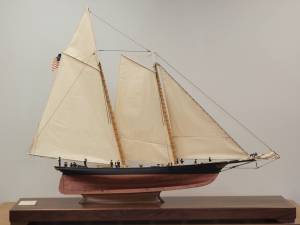
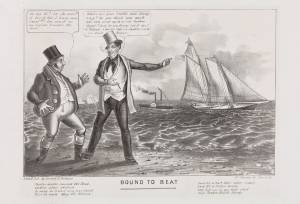
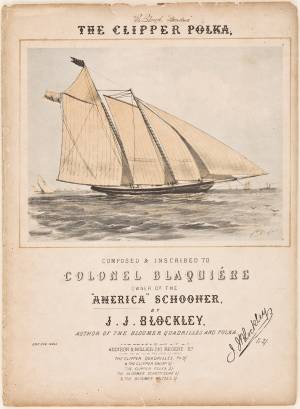
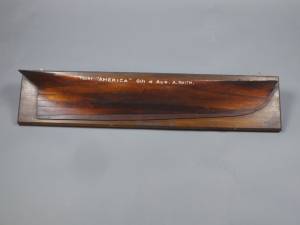

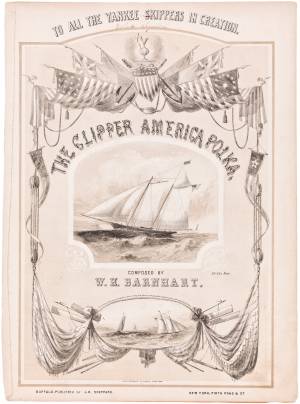

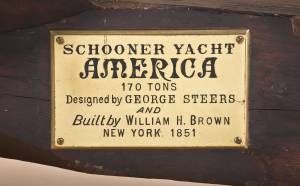
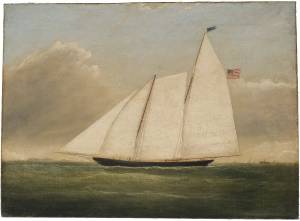
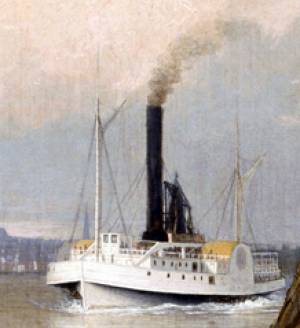

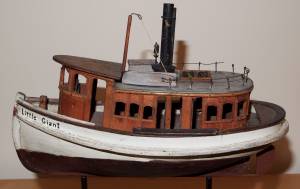


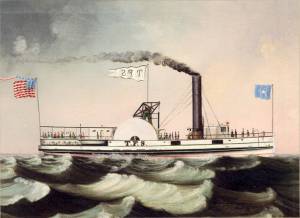
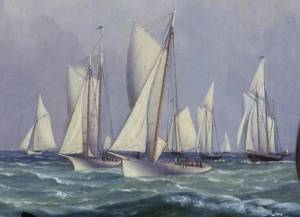
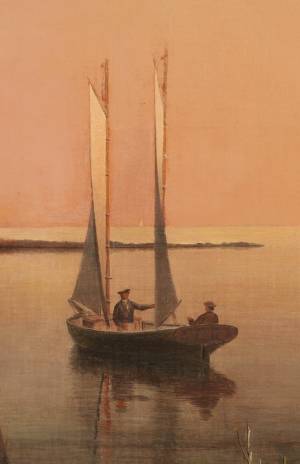



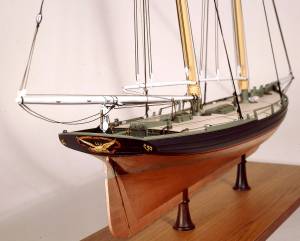


Commentary
Lane’s depiction of the schooner yacht "America’s" victory at Cowes, England, is a close copy of Thomas Dutton’s lithograph, which in turn was based on an on-site drawing of the occasion by Oswald W. Brierly. The differences between the painting and its source are most noticeable in the sea and sky. The water in the Lane foreground is dark, enhancing the contrast between the schooner and the light green water surrounding it. Lane’s sky is also more dramatic, with a more defined bank of cumulus clouds on the horizon and whisps of cirrocumulus above.
On the horizon at left are The Needles, a striking formation of chalk rising out of the sea at the far west end of the Isle of Wight. The Needles were the turning point for the final leg of the race for the Queen’s Cup (as the America’s Cup was then called). Most of the Royal Yacht Squadron’s participants have cleared this mark and are bearing off for the downwind run through the Solent, the strait separating the Isle of Wight from the English mainland.
Only one cutter (left) is anywhere near "America" as she romps, with her sails wing and wing, to the finish line. In the right foreground, a small ketch-rigged pleasure boat hoists sail as its passengers raise their hats and cheer the schooner on. Neither of two large steam yachts in the background appear to be flying royal colors, so they are likely private yachts with guest observers packed closely on board. (1)
Ironically, Lane’s detailing of "America" dispenses with deck and rigging details shown in the Dutton lithograph and other reliable sources. The omitted details include: after companionway and cabin skylight, capstan, and main topmast stay, as well as foresail and fore-staysail bonnets. All are items with which Lane showed familiarity in his other depictions of schooners—both yachts and working craft. The absence of deck detail is not even consistent with what we see in his earlier “Three Views” depiction of "America" in her conceptual state (see Yacht "America" from Three Views, c.1851 (inv. 395)).
Earlier efforts to relate this painting to its subject have led to the conclusion that "America" was in an early stage of design or construction when (and if) Lane had the opportunity to inspect it. He therefore never saw the schooner in its complete state and may have decided to depict only those details of which he was certain. Lacking any information regarding the painting’s early provenance, it seems unwise to speculate further. (2)
– Erik Ronnberg
References:
1. John Rousmaniere, The Low Black Schooner: Yacht America, 1851–1945 (Mystic, CT: Mystic Seaport Museum Stores, Inc., 1986), 27–38.
2. Erik A.R. Ronnberg, Jr., “Fitz Henry Lane’s Yacht America from Three Views: Vessel Portrait or Artist’s Concept”, Antiques and Fine Arts (Summer/Autumn 2010): 174–79.
[+] See More